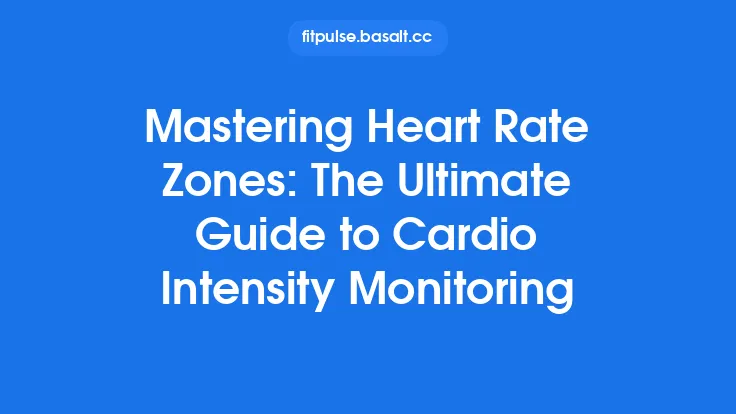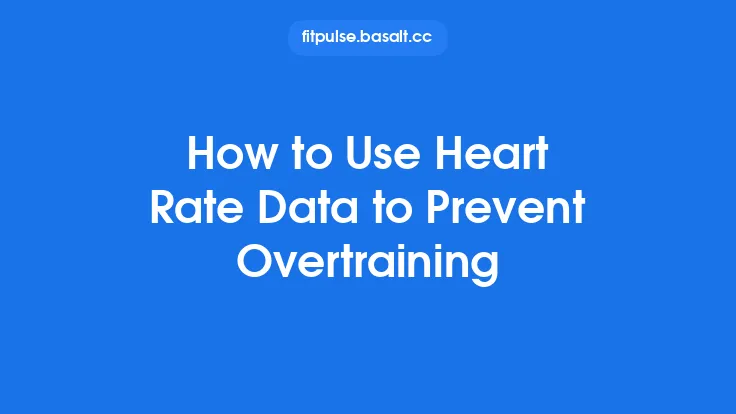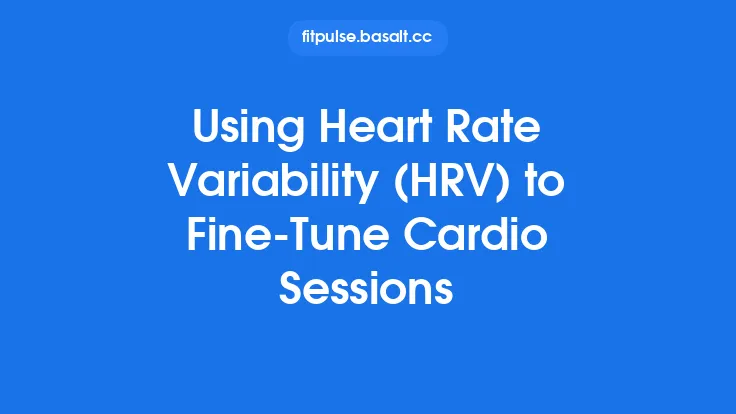When you lace up for a run, hop on the bike, or step onto the elliptical, the most immediate feedback you have isn’t the distance on the screen or the cadence on the console—it’s the beat of your own heart. Modern wearables stream that pulse to your wrist or phone in real time, giving you a live window into how hard your body is working. By learning to read and react to that window, you can fine‑tune the intensity of any cardio session on the spot, keeping you in the optimal training range, avoiding premature fatigue, and making every minute count.
Why Real‑Time Heart Rate Matters
- Physiological fidelity – Heart rate (HR) is a direct proxy for oxygen demand, metabolic stress, and sympathetic nervous system activation. Unlike perceived effort, which can be clouded by mood or external distractions, HR provides an objective, moment‑to‑moment snapshot of internal load.
- Dynamic environments – Outdoor runs, indoor classes, and even treadmill sessions are subject to changing temperature, humidity, wind, and terrain. Real‑time HR automatically incorporates those variables, letting you adjust without having to guess how they’re affecting you.
- Safety net – Sudden spikes in HR can signal early signs of overexertion, dehydration, or cardiac strain. Immediate awareness lets you back off before a problem escalates.
- Training efficiency – Staying within the intended intensity band maximizes the specific adaptations you’re targeting—whether that’s improving aerobic capacity, sharpening lactate clearance, or building endurance reserves.
Reading the Live Signal: What the Numbers Tell You
- Baseline drift – At the start of a session, HR climbs quickly to meet the metabolic demands of the activity. As you settle into a steady state, the curve flattens. A gradual upward drift (often called “cardiovascular drift”) while speed or power remains constant suggests accumulating fatigue, heat stress, or dehydration.
- Instantaneous spikes – Short, sharp increases (lasting a few seconds) are usually benign—think of a brief hill surge or a sprint interval. However, spikes that persist beyond 30–60 seconds without a corresponding increase in external workload may indicate that the current intensity is too high for your current condition.
- Recovery dips – After a hard effort, HR should fall rapidly during the recovery phase. A sluggish decline (e.g., less than 12 bpm drop in the first minute) can be a warning sign that your autonomic balance is compromised, prompting a reduction in subsequent effort.
- Variability within a set – Even within a single interval, HR can fluctuate due to breathing patterns, stride length changes, or minor terrain shifts. Small, regular oscillations are normal; erratic, large swings often point to inconsistent pacing.
Detecting Early Signs of Over‑ or Under‑Intensity
| Indicator | What It Means | Quick Action |
|---|---|---|
| Steady upward drift > 5 bpm per 5 min while speed/power unchanged | Accumulating fatigue or heat stress | Reduce pace/power by 5–10 % or add a brief low‑intensity recovery |
| HR plateau at the top of your target range despite feeling easy | Possible under‑loading; you may be able to push harder | Increase cadence or resistance modestly (5 % increments) |
| HR spikes that outpace power output (e.g., HR jumps 15 bpm while power stays flat) | Stress from external factors (heat, dehydration) | Hydrate, seek shade, or lower intensity |
| Recovery HR > 80 % of peak HR after 2 min | Inadequate recovery, high sympathetic tone | Insert a longer active recovery or pause the session |
Using Simple On‑Device Alerts to Guide Adjustments
Most modern wearables let you set threshold alerts based on HR values. Rather than relying on static “zone” labels, think of these alerts as dynamic guardrails:
- Upper‑limit alert – Triggered when HR exceeds a pre‑determined buffer (e.g., 5 bpm above the intended training band). The device can vibrate or display a visual cue, prompting you to ease off.
- Drift alert – Configured to fire if HR rises continuously for a set period (e.g., 3 min) without a corresponding increase in speed/power. This helps catch cardiovascular drift early.
- Recovery alert – Notifies you when HR fails to drop below a target threshold within a given recovery window, suggesting you need a longer rest.
Because these alerts are customizable, you can tighten or loosen them as you become more comfortable interpreting the raw data. The key is to treat the alerts as decision prompts, not automatic commands; you still decide the exact adjustment based on the context.
Practical Strategies for Immediate Intensity Tweaks
- Micro‑adjust cadence or stride length
Running: If HR is creeping upward, shorten your stride slightly and increase turnover. This often reduces impact forces and oxygen cost without sacrificing speed.
Cycling: Shift to a slightly lower gear and spin faster; the smoother pedal stroke can lower HR while maintaining power output.
- Modulate resistance or incline in small increments
On a treadmill or elliptical, change the incline by 0.5–1 % rather than large jumps. On a stationary bike, adjust the resistance knob in the smallest possible step. These fine‑tuned changes keep HR within the desired window without shocking the system.
- Incorporate “breathing breaks”
A 10–15 second pause in effort, focusing on deep diaphragmatic breaths, can accelerate HR recovery. Use this during long steady‑state efforts when you notice a drift.
- Leverage interval “reset” points
If you’re doing a structured interval set, treat the recovery segment as a chance to recalibrate. Observe how quickly HR drops; if it’s slower than expected, extend the recovery or lower the next work interval’s intensity.
- Adjust environmental variables on the fly
Heat: Reduce intensity by 5–10 % and increase fluid intake.
Altitude: Accept a naturally higher HR for a given effort; compensate by lowering absolute workload until acclimatization occurs.
Wind: On outdoor runs, a headwind will raise HR; consider a slight pace reduction or a brief walk‑break when the wind gusts.
Adapting to External Variables (Heat, Altitude, Fatigue)
Real‑time HR data shines when external stressors change mid‑session:
- Heat stress – As ambient temperature rises, HR will climb even if you keep the same speed. Monitor the rate of increase; a rapid rise (> 10 bpm within 2 min) signals that you should proactively lower intensity before dehydration sets in.
- Altitude – The lower oxygen pressure forces HR upward for any given workload. Use HR as a relative intensity gauge rather than an absolute target; aim for a consistent drift pattern rather than a fixed number.
- Cumulative fatigue – If you’re training on consecutive days, your resting HR may be slightly elevated. In-session HR will reflect this baseline, so compare the delta (difference between resting HR and current HR) rather than the absolute value.
By treating HR as a relative barometer—how far it is from your immediate baseline—you can make nuanced adjustments that respect the day’s unique physiological context.
Progressive Session Design with Live HR Feedback
- Warm‑up with a “HR slope” check
Begin at a very easy pace and gradually increase intensity every 2 minutes. Plot HR on a simple graph (many apps do this automatically). The slope should be smooth; any abrupt jumps suggest a need to adjust the warm‑up progression.
- Set a “target drift band”
Instead of a static zone, define an acceptable HR drift range (e.g., no more than +3 bpm per 5 minutes). This band becomes your real‑time performance envelope.
- Embed “auto‑adjust windows”
Every 10–15 minutes, pause for a 30‑second assessment: check HR trend, perceived breathlessness, and external conditions. Use that snapshot to decide whether to stay steady, step up, or step down.
- Cool‑down guided by HR recovery rate
Aim for a specific recovery rate (e.g., 15 bpm drop in the first minute). If you’re not hitting that, extend the cool‑down or lower the intensity further.
By structuring the session around continuous HR feedback loops, you turn a static workout into a responsive, data‑driven experience.
Post‑Session Review: Translating Real‑Time Data into Future Plans
After the workout, export the HR trace (most platforms allow CSV or integrated dashboards). Look for:
- Peak HR vs. intended intensity – Did you ever exceed the safe upper buffer? If so, note the circumstances (terrain, temperature, hydration) that contributed.
- Drift patterns – Identify sections where HR drifted upward without a workload change. These are candidates for future intensity reductions or additional hydration.
- Recovery kinetics – Calculate the time needed for HR to fall below 60 % of peak. Slower recoveries may indicate the need for more rest days or a lower training load in the upcoming week.
Use these insights to refine your alert thresholds, adjust your micro‑adjustment strategies, and plan the next session’s intensity targets.
Common Tools and Apps that Facilitate On‑The‑Fly Adjustments
| Tool | Core Feature for Real‑Time Adjustment | How It Helps |
|---|---|---|
| Garmin Connect IQ widgets | Customizable HR alerts, live HR graph overlay on activity screen | Immediate visual cue without leaving the workout view |
| Polar Flow Live | Real‑time HR zones with vibration alerts, “training load” indicator | Combines objective HR data with a simple load metric |
| Wahoo Fitness app | Adjustable HR thresholds, auto‑pause on exceeding limits | Auto‑pause can be a safety net for high‑intensity intervals |
| Strava Live Segments + HR | Shows HR at segment start/finish, enabling segment‑specific intensity tweaks | Ideal for road runners who want to stay within a target HR for each segment |
| TrainingPeaks “Live” | Real‑time HR overlay on power/pace, customizable alerts | Great for cyclists who pair HR with power data for nuanced pacing |
Most of these platforms let you export the raw HR stream for deeper analysis, ensuring that the on‑the‑fly decisions you make today become data‑backed refinements for tomorrow.
Putting It All Together: A Sample Workout Walkthrough
Scenario: 45‑minute outdoor run on a warm (28 °C) day, aiming for a steady aerobic stimulus without overtaxing the cardiovascular system.
- Warm‑up (0‑8 min) – Easy jog at 5 km/h. HR climbs from 70 bpm to 115 bpm. No alerts fire.
- Build‑up (8‑12 min) – Increase to 7 km/h. HR reaches 135 bpm, still within the pre‑set upper buffer (140 bpm). No drift yet.
- Steady state (12‑30 min) – Maintain 7 km/h. At minute 20, HR begins a slow upward drift: 135 → 142 bpm over 5 minutes, while speed stays constant. The drift alert triggers.
- Action: Reduce pace to 6.5 km/h for 2 minutes, then resume 7 km/h. HR drops back to 138 bpm, drift stabilizes.
- Mid‑session check (30‑32 min) – Quick 30‑second breathing break. HR falls 12 bpm in 30 seconds, confirming recovery is on track.
- Final push (32‑40 min) – Slightly increase to 7.5 km/h. HR climbs to 150 bpm, hitting the upper‑limit alert (set at 152 bpm).
- Action: Maintain 7.5 km/h for 1 minute, then drop back to 7 km/h for the remaining time.
- Cool‑down (40‑45 min) – Slow jog to 5 km/h. HR drops from 150 bpm to 110 bpm in the first minute, meeting the recovery target.
Post‑run analysis: Exported HR trace shows a single drift episode that was corrected with a modest pace reduction, and the final push stayed just below the safety buffer. The data informs the next run: perhaps start at 6.5 km/h to pre‑empt the drift, and consider a slightly earlier hydration sip.
By treating real‑time heart rate as a living dashboard rather than a static number, you gain the ability to sculpt cardio intensity moment by moment. The process blends physiological insight, simple on‑the‑fly adjustments, and technology‑enabled alerts, creating a feedback loop that keeps you training efficiently, safely, and adaptively—no matter the terrain, temperature, or how you feel on any given day.





